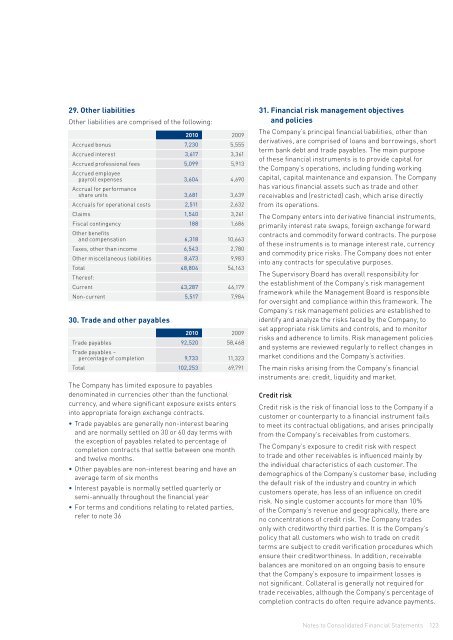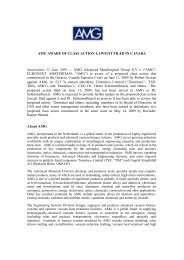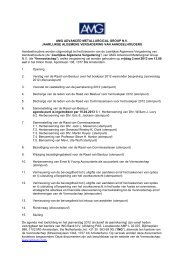C Si Ni Cr V Ti Ta Sc Li Sr Zr Fe Cu Zn Sn B Al Ce U Mn Mo Nb Sb
C Si Ni Cr V Ti Ta Sc Li Sr Zr Fe Cu Zn Sn B Al Ce U Mn Mo Nb Sb
C Si Ni Cr V Ti Ta Sc Li Sr Zr Fe Cu Zn Sn B Al Ce U Mn Mo Nb Sb
Create successful ePaper yourself
Turn your PDF publications into a flip-book with our unique Google optimized e-Paper software.
29. Other liabilities<br />
Other liabilities are comprised of the following:<br />
2010 2009<br />
Accrued bonus 7,230 5,555<br />
Accrued interest 3,617 3,361<br />
Accrued professional fees 5,099 5,913<br />
Accrued employee<br />
payroll expenses<br />
Accrual for performance<br />
3,604 4,690<br />
share units 3,681 3,639<br />
Accruals for operational costs 2,511 2,632<br />
Claims 1,540 3,261<br />
Fiscal contingency<br />
Other benefits<br />
188 1,686<br />
and compensation 6,318 10,663<br />
<strong>Ta</strong>xes, other than income 6,543 2,780<br />
Other miscellaneous liabilities 8,473 9,983<br />
Total<br />
Thereof:<br />
48,804 54,163<br />
<strong>Cu</strong>rrent 43,287 46,179<br />
Non-current 5,517 7,984<br />
30. Trade and other payables<br />
2010 2009<br />
Trade payables<br />
Trade payables –<br />
92,520 58,468<br />
percentage of completion 9,733 11,323<br />
Total 102,253 69,791<br />
The Company has limited exposure to payables<br />
denominated in currencies other than the functional<br />
currency, and where significant exposure exists enters<br />
into appropriate foreign exchange contracts.<br />
• Trade payables are generally non-interest bearing<br />
and are normally settled on 30 or 60 day terms with<br />
the exception of payables related to percentage of<br />
completion contracts that settle between one month<br />
and twelve months.<br />
• Other payables are non-interest bearing and have an<br />
average term of six months<br />
• Interest payable is normally settled quarterly or<br />
semi-annually throughout the financial year<br />
• For terms and conditions relating to related parties,<br />
refer to note 36<br />
31. Financial risk management objectives<br />
and policies<br />
The Company’s principal financial liabilities, other than<br />
derivatives, are comprised of loans and borrowings, short<br />
term bank debt and trade payables. The main purpose<br />
of these financial instruments is to provide capital for<br />
the Company’s operations, including funding working<br />
capital, capital maintenance and expansion. The Company<br />
has various financial assets such as trade and other<br />
receivables and (restricted) cash, which arise directly<br />
from its operations.<br />
The Company enters into derivative financial instruments,<br />
primarily interest rate swaps, foreign exchange forward<br />
contracts and commodity forward contracts. The purpose<br />
of these instruments is to manage interest rate, currency<br />
and commodity price risks. The Company does not enter<br />
into any contracts for speculative purposes.<br />
The Supervisory Board has overall responsibility for<br />
the establishment of the Company’s risk management<br />
framework while the Management Board is responsible<br />
for oversight and compliance within this framework. The<br />
Company’s risk management policies are established to<br />
identify and analyze the risks faced by the Company, to<br />
set appropriate risk limits and controls, and to monitor<br />
risks and adherence to limits. Risk management policies<br />
and systems are reviewed regularly to reflect changes in<br />
market conditions and the Company’s activities.<br />
The main risks arising from the Company’s financial<br />
instruments are: credit, liquidity and market.<br />
<strong>Cr</strong>edit risk<br />
<strong>Cr</strong>edit risk is the risk of financial loss to the Company if a<br />
customer or counterparty to a financial instrument fails<br />
to meet its contractual obligations, and arises principally<br />
from the Company’s receivables from customers.<br />
The Company’s exposure to credit risk with respect<br />
to trade and other receivables is influenced mainly by<br />
the individual characteristics of each customer. The<br />
demographics of the Company’s customer base, including<br />
the default risk of the industry and country in which<br />
customers operate, has less of an influence on credit<br />
risk. No single customer accounts for more than 10%<br />
of the Company’s revenue and geographically, there are<br />
no concentrations of credit risk. The Company trades<br />
only with creditworthy third parties. It is the Company’s<br />
policy that all customers who wish to trade on credit<br />
terms are subject to credit verification procedures which<br />
ensure their creditworthiness. In addition, receivable<br />
balances are monitored on an ongoing basis to ensure<br />
that the Company’s exposure to impairment losses is<br />
not significant. Collateral is generally not required for<br />
trade receivables, although the Company’s percentage of<br />
completion contracts do often require advance payments.<br />
Notes to Consolidated Financial Statements 123







